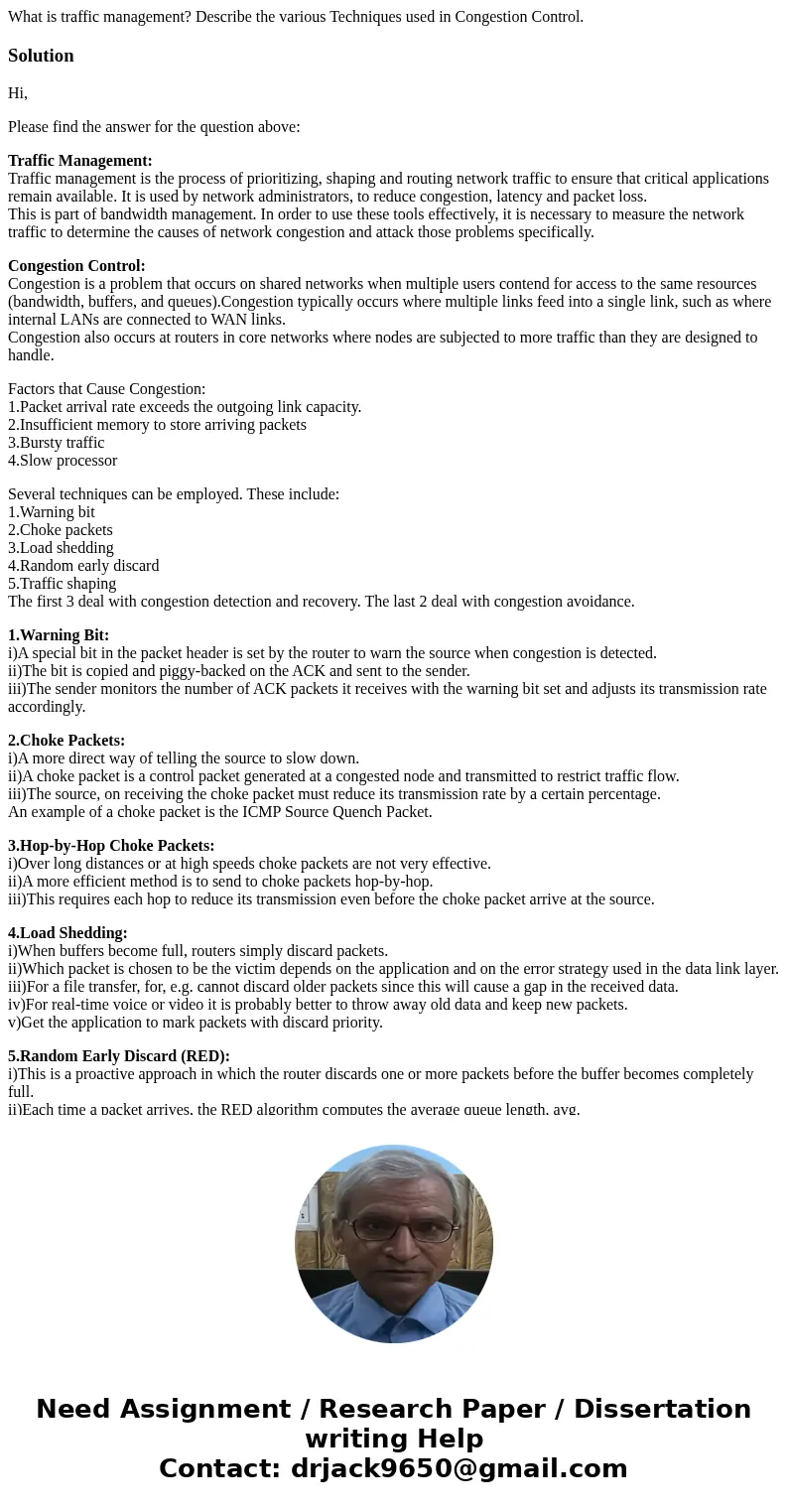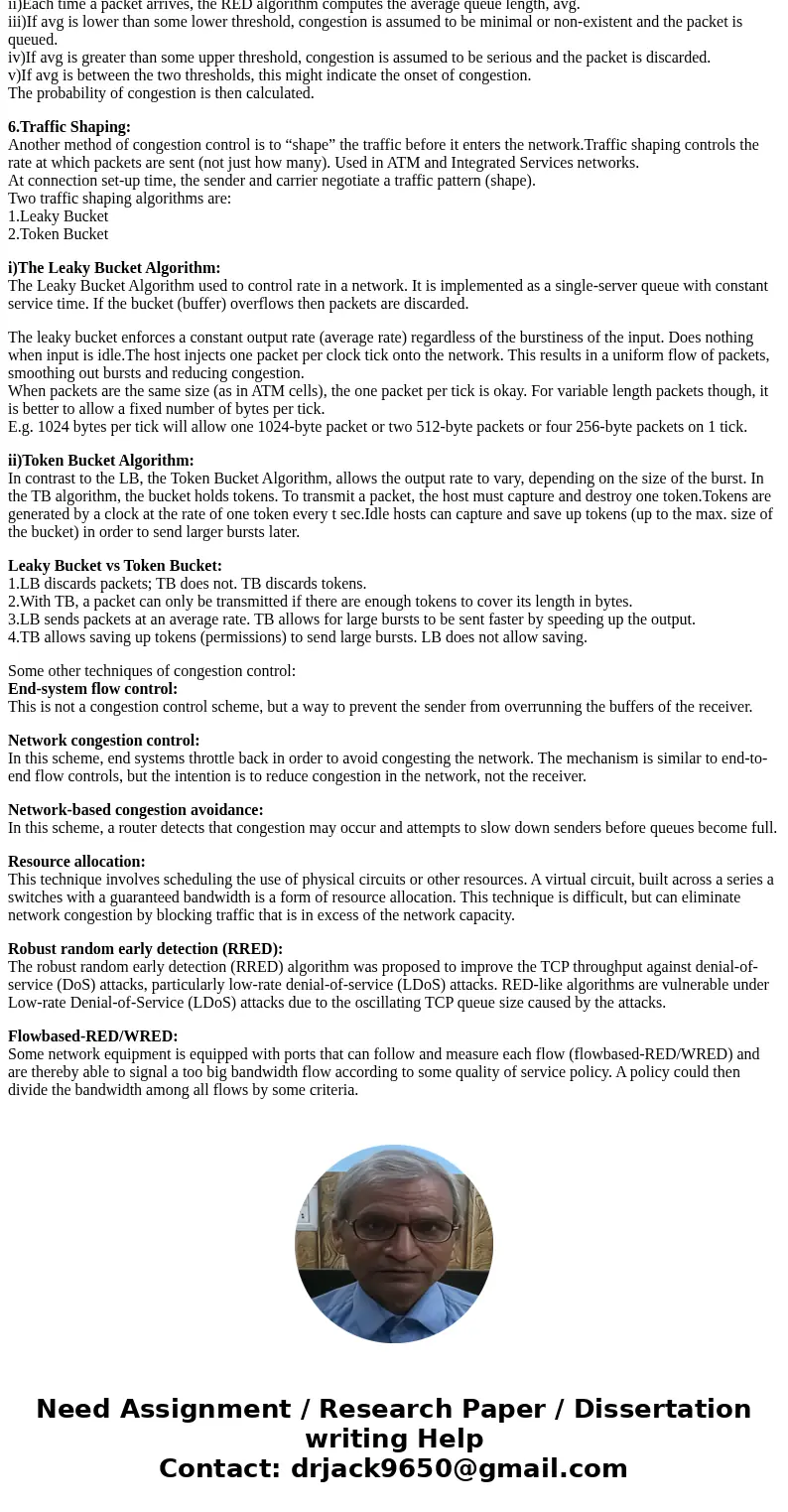What is traffic management Describe the various Techniques u
What is traffic management? Describe the various Techniques used in Congestion Control.
Solution
Hi,
Please find the answer for the question above:
Traffic Management:
Traffic management is the process of prioritizing, shaping and routing network traffic to ensure that critical applications remain available. It is used by network administrators, to reduce congestion, latency and packet loss.
This is part of bandwidth management. In order to use these tools effectively, it is necessary to measure the network traffic to determine the causes of network congestion and attack those problems specifically.
Congestion Control:
Congestion is a problem that occurs on shared networks when multiple users contend for access to the same resources (bandwidth, buffers, and queues).Congestion typically occurs where multiple links feed into a single link, such as where internal LANs are connected to WAN links.
Congestion also occurs at routers in core networks where nodes are subjected to more traffic than they are designed to handle.
Factors that Cause Congestion:
1.Packet arrival rate exceeds the outgoing link capacity.
2.Insufficient memory to store arriving packets
3.Bursty traffic
4.Slow processor
Several techniques can be employed. These include:
1.Warning bit
2.Choke packets
3.Load shedding
4.Random early discard
5.Traffic shaping
The first 3 deal with congestion detection and recovery. The last 2 deal with congestion avoidance.
1.Warning Bit:
i)A special bit in the packet header is set by the router to warn the source when congestion is detected.
ii)The bit is copied and piggy-backed on the ACK and sent to the sender.
iii)The sender monitors the number of ACK packets it receives with the warning bit set and adjusts its transmission rate accordingly.
2.Choke Packets:
i)A more direct way of telling the source to slow down.
ii)A choke packet is a control packet generated at a congested node and transmitted to restrict traffic flow.
iii)The source, on receiving the choke packet must reduce its transmission rate by a certain percentage.
An example of a choke packet is the ICMP Source Quench Packet.
3.Hop-by-Hop Choke Packets:
i)Over long distances or at high speeds choke packets are not very effective.
ii)A more efficient method is to send to choke packets hop-by-hop.
iii)This requires each hop to reduce its transmission even before the choke packet arrive at the source.
4.Load Shedding:
i)When buffers become full, routers simply discard packets.
ii)Which packet is chosen to be the victim depends on the application and on the error strategy used in the data link layer.
iii)For a file transfer, for, e.g. cannot discard older packets since this will cause a gap in the received data.
iv)For real-time voice or video it is probably better to throw away old data and keep new packets.
v)Get the application to mark packets with discard priority.
5.Random Early Discard (RED):
i)This is a proactive approach in which the router discards one or more packets before the buffer becomes completely full.
ii)Each time a packet arrives, the RED algorithm computes the average queue length, avg.
iii)If avg is lower than some lower threshold, congestion is assumed to be minimal or non-existent and the packet is queued.
iv)If avg is greater than some upper threshold, congestion is assumed to be serious and the packet is discarded.
v)If avg is between the two thresholds, this might indicate the onset of congestion.
The probability of congestion is then calculated.
6.Traffic Shaping:
Another method of congestion control is to “shape” the traffic before it enters the network.Traffic shaping controls the rate at which packets are sent (not just how many). Used in ATM and Integrated Services networks.
At connection set-up time, the sender and carrier negotiate a traffic pattern (shape).
Two traffic shaping algorithms are:
1.Leaky Bucket
2.Token Bucket
i)The Leaky Bucket Algorithm:
The Leaky Bucket Algorithm used to control rate in a network. It is implemented as a single-server queue with constant service time. If the bucket (buffer) overflows then packets are discarded.
The leaky bucket enforces a constant output rate (average rate) regardless of the burstiness of the input. Does nothing when input is idle.The host injects one packet per clock tick onto the network. This results in a uniform flow of packets, smoothing out bursts and reducing congestion.
When packets are the same size (as in ATM cells), the one packet per tick is okay. For variable length packets though, it is better to allow a fixed number of bytes per tick.
E.g. 1024 bytes per tick will allow one 1024-byte packet or two 512-byte packets or four 256-byte packets on 1 tick.
ii)Token Bucket Algorithm:
In contrast to the LB, the Token Bucket Algorithm, allows the output rate to vary, depending on the size of the burst. In the TB algorithm, the bucket holds tokens. To transmit a packet, the host must capture and destroy one token.Tokens are generated by a clock at the rate of one token every t sec.Idle hosts can capture and save up tokens (up to the max. size of the bucket) in order to send larger bursts later.
Leaky Bucket vs Token Bucket:
1.LB discards packets; TB does not. TB discards tokens.
2.With TB, a packet can only be transmitted if there are enough tokens to cover its length in bytes.
3.LB sends packets at an average rate. TB allows for large bursts to be sent faster by speeding up the output.
4.TB allows saving up tokens (permissions) to send large bursts. LB does not allow saving.
Some other techniques of congestion control:
End-system flow control:
This is not a congestion control scheme, but a way to prevent the sender from overrunning the buffers of the receiver.
Network congestion control:
In this scheme, end systems throttle back in order to avoid congesting the network. The mechanism is similar to end-to-end flow controls, but the intention is to reduce congestion in the network, not the receiver.
Network-based congestion avoidance:
In this scheme, a router detects that congestion may occur and attempts to slow down senders before queues become full.
Resource allocation:
This technique involves scheduling the use of physical circuits or other resources. A virtual circuit, built across a series a switches with a guaranteed bandwidth is a form of resource allocation. This technique is difficult, but can eliminate network congestion by blocking traffic that is in excess of the network capacity.
Robust random early detection (RRED):
The robust random early detection (RRED) algorithm was proposed to improve the TCP throughput against denial-of-service (DoS) attacks, particularly low-rate denial-of-service (LDoS) attacks. RED-like algorithms are vulnerable under Low-rate Denial-of-Service (LDoS) attacks due to the oscillating TCP queue size caused by the attacks.
Flowbased-RED/WRED:
Some network equipment is equipped with ports that can follow and measure each flow (flowbased-RED/WRED) and are thereby able to signal a too big bandwidth flow according to some quality of service policy. A policy could then divide the bandwidth among all flows by some criteria.


 Homework Sourse
Homework Sourse